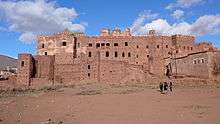Telouet Kasbah
Telouet Kasbah (Berber: ⵉⵖⵔⵎ ⵏ ⵜⵍⵡⴰⵜ; Arabic: قصبة تلوات; French: Casbah de Télouet) is a Kasbah along the former route of the caravans from the Sahara over the Atlas Mountains to Marrakech. The kasbah was the seat of the El Glaoui family's power, thus sometimes also called the Palace of Glaoui, and it was built in the 18th and 19th centuries. The palace can still be visited but it is steadily becoming more damaged and is slowly collapsing. In 2010, work was underway to restore the property.[1]

Location
The palace is located on the outskirts of the small Berber village of Télouet, in Morocco. It lies at an elevation of 1,800 metres (5,900 ft). Occupying a strategic position in the High Atlas, the occupants of the palace had the privilege of being on the passage of caravans and near major salt mines. The kasbah and the village are now accessible by the P1506 road which, coming from the north, is accessed by a junction near the Tizi n'Tichka, from the RN9 road that connects Marrakech to Ouarzazate.
History

The passage of the merchant caravans, which connected the desert with the large cities situated on the other side of the Atlas, and the proximity of the salt mines, made the wealth of the Pashas inhabiting Telouet. The current kasbah was built from 1860s by El Glaoui family, next to an ancient kasbah whose remains are still visible today. It was subsequently considerably enlarged during the first half of the twentieth century. Legend has it that 300 workers worked for three years to decorate the ceilings and walls. These are made of stucco, zelliges for the walls, and cedar painting for the ceiling. The roofs are covered with ceramic tiles painted green.
The support given to French by El Glaoui, often called the Glaoui during the French occupation in Morocco, earned him the reciprocal support of the French colonial authorities. At the height of his power, the Glaoui family had considerable wealth, making him one of the country's leading figures. But this commitment turned against him during the increasing rise towards the independence of Morocco. He died in oblivion in Marrakech in 1953. The funeral procession was presided over by Crown Prince Moulay Hassan ben Mohammed, the future ruler of Morocco as Hassan II. Since then, mainly because of such political connotation, the kasbah has been almost abandoned.
Tourism
The kasbah is still visited today, via local guides. Entry is monitored by a guard, who receives low entry fees.
References
- "Reviving the last Pasha of Marrakech". BBC News. 28 June 2010. Retrieved 30 June 2010.
External links
- Telouet: Kasbah of the Glaouis at Lexicorient.com
- (in German) Telouet at g26.ch
- (in French) S.O.S., la Kasbah de Telouet agonise at eMarrakech.info